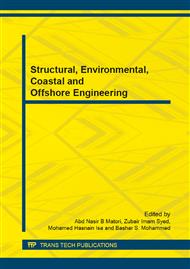[1]
V. K Gusiakov, Tsunami history: recorded in The Sea, Harvard University Press, Cambridge, 15 (2009) 23–54.
Google Scholar
[2]
P. Watt, Tsunami features of solid block underwater landslide, Journal of Waterway, Port, Coastal and Ocean Engineering (2000).
DOI: 10.1061/(asce)0733-950x(2000)126:3(144)
Google Scholar
[3]
T.S. Murty, Tsunami wave height dependence on landslide volume, Pure and Applied Geophysics 160 (2003) 1-7.
DOI: 10.1007/s00024-003-2423-z
Google Scholar
[4]
L. J. Ruff, Some Aspects of Energy Balance and Tsunami Generation by Earthquakes and Landslides, Pure Appl. Geophys. 160 (2003) 2155–2176.
DOI: 10.1007/s00024-003-2424-y
Google Scholar
[5]
E. A. Okal, C. E. Synolakis, Theoretical Comparison of Tsunamis from Dislocations and Landslides, Pure Appl. Geophys. 160 (2003) 2177–2188.
DOI: 10.1007/s00024-003-2425-x
Google Scholar
[6]
S. T. Grilli and P. Watts, Modeling of waves generated by a moving submerged body: Applications to underwater landslides, Engrg. Analysis with Boundary Elements (1999) 645-656.
DOI: 10.1016/s0955-7997(99)00021-1
Google Scholar
[7]
D. R Tappin, Digital elevation models in the marine domain: investigating the offshore tsunami hazard from submarine landslide, Geol. Soc. London (2010) 81-101.
DOI: 10.1144/sp345.10
Google Scholar
[8]
D.R. Tappin, Submarine Mass Failures as tsunami sources – their climate control, Phil. Trans. R. Soc. A 368 (2010) 2417–2434.
DOI: 10.1098/rsta.2010.0079
Google Scholar
[9]
P. J. Lynett and P. L. -F. Liu, A numerical study of submarine-landslide-generated waves and run-up, Proc. R. Soc. Lond. A 458, vol. 458 (2002) 2885-2910.
DOI: 10.1098/rspa.2002.0973
Google Scholar
[10]
P. J. Lynett, J. C. Borrero, P. L. -F. Liu, and C. E. Synolakis, Field Survey and NumericalSimulations: A Review of the 1998 Papua New Guinea Tsunami, Pure Appl. Geophys, vol. 160 (2003) 2119-2146.
DOI: 10.1007/s00024-003-2422-0
Google Scholar
[11]
D. Yuk, S. C. Yim, and P. L. -F. Liu, Numerical modeling of submarine mass-movement generated waves using RANS model, Computers & Geosciences, vol. 32, no. 7 (2006) 927-935.
DOI: 10.1016/j.cageo.2005.10.028
Google Scholar
[12]
E. A. Okal and C. E. Synolakis, Source discriminants for near-field tsunamis, Geophys. J. Int., 158 (2004) 899 – 912.
DOI: 10.1111/j.1365-246x.2004.02347.x
Google Scholar
[13]
S. T. Grilli, M. Ioualalen, J. Asavanant, F. Shi, J. T. Kirby, and P. Watts, Source constraintsand model simulation of the December26, 2004 Indian Ocean Tsunami, Journal of Waterway, Port, Ocean and Coastal Engineering, vol. 133, no. 6 (2007).
DOI: 10.1061/(asce)0733-950x(2007)133:6(414)
Google Scholar
[14]
D. Yuk, S. C. Yim, and P. L. -F. Liu, Numerical modeling of submarine mass-movement generated waves using RANS model, Computers & Geosciences, vol. 32, no. 7 (2006) 927-935.
DOI: 10.1016/j.cageo.2005.10.028
Google Scholar
[15]
T. Capone, A. Panizzo, and J. J. Monaghan, SPH modelling of water waves generated by submarine landslides, Journal of Hydraulic Research, vol. 48, no. 1 (2010) 80-84.
DOI: 10.1080/00221686.2010.9641248
Google Scholar
[16]
N. I. Thusyanthan, S. P. Gopal, Tsunami wave loading on coastal houses: a model approach, Civil Engineering 16 (2008) 77–86.
DOI: 10.1680/cien.2008.161.2.77
Google Scholar
[17]
T. Okada et al, Tsunami Loads and Structural Design of Tsunami Refuge Buildings, (2005).
Google Scholar
[18]
T. Arikawa, Tsunami and Damage to Coastal Facilities of the March 11, 2011, Tohoku, Japan Earthquake, 15th World Conference on Earthquake Engineering (2012).
Google Scholar


